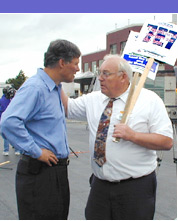Jay Inslee: Washington's 1st Congressional District
Issues
Veterans
Local Veterans to Receive Bronze Star Medal
"Remember the Sacrifices of These American Heroes"
2 July 2002
Mountlake Terrace – U.S. Rep. Jay Inslee awarded the Bronze Star Medal to several local World War II Army veterans and their families at an award ceremony in the Edmonds Historical Museum. Veterans from Bothell, Kenmore, Kirkland, Redmond, and Seattle received the medal.
The Fort Lewis Colorguard participated in the ceremony, and students from the Maplewood Coop School in Edmonds presented their Memorial Flag Quilt, which represents the lives of eighty American veterans as seen through the eyes of their children and grandchildren.
Many deserving veterans never received the Bronze Star Medal, which was awarded to soldiers in the Army who bore hardships on the ground during WWII, because the criteria for the medal changed a few years after the war was over. "I am honored to help these veterans and their families obtain the recognition they rightfully deserve," said Inslee. "These veterans set an example for younger generations by their honorable service to our nation."
| Read newspaper articles about this event |
|---|
More info on some of the veterans who received the Bronze Medal
Bothell
Jerry Peal of Bothell received the medal on behalf of his father, Elmer Peal. Elmer Peal was drafted into the Army in 1944, and became part of the Luzon Campaign to take back the Philippines from the Japanese forces. He was wounded early in the year, returned to continue his service, and was killed in battle in 1945. Mr. Peal left a widow and three young children.
Harold Enger left the United States for Africa in 1944, where he was assigned to the 355th Regiment of the 88th Division in Italy. During the allied campaign in Italy, Mr. Enger was involved in heavy fighting for over two months as Allied forces pushed North to the Alps. In battle on Mt. Battaglia, Harold sustained a near-death injury from a German mortar, but after fourteen weeks in the hospital, he was sent back to the front line to fight until the German's retreat. After spending eleven months in front line combat, Harold returned to the United States in August of 1945 and married his wife, Phyllis Enger.
Kenmore
Robert Zappone volunteered for service in the Army and was a machine-gunner in the 407th Infantry Regimen of the 102nd Division. Robert fought in France and Germany, and later became part of the Army of Occupation following the German defeat. Throughout his service, Robert played the trumpet in a number of bands that he helped to organize, and during his time in Germany, he became the entertainment director for his musical work and publication of a servicemen newspaper. Upon his return to the United States in April, 1946, Robert attended Gonzaga University, married, and had five children.
Kirkland
Ernest Schear, Jr. of Kirkland received the medal for his service in the Pacific.
Redmond
Charles Anders from Snohomish County fought briefly at the Battle of the Bulge, and later in the French Alps. Anders was in the infantry, and he remembers enduring the cold winters sleeping in foxholes, saying that the "trenchfoot was terrible."
James Elmar Owens was inducted into the Army in 1943. Mr. Owens served as a rifleman with Company C, in the 18th Infantry Regiment. Elmar fought in the frontlines in the battle on Crucifix Hill, a pillbox-studded position key to the defense of Aachen Germany. Mr. Owens was the only survivor in his platoon on one occasion and the only one of two survivors on two other occasions. For this he received the Distinguished Unit Badge. Elmar married his wife Frances in 1948– they have been married 54 years, have four children and eight grandchildren.
Seattle:
William Neilsen participated in the German campaign as a rifleman in the Battle of the Bulge. William was shot by a German sniper during combat, and received the Purple Heart for sustaining this injury. Upon his return from the War, William married his wife, Virginia, and became a pioneer in the field of optometry, developing a number of breakthroughs in the areas of child vision and color in vision. He was actively involved in working with low-income children in the Seattle area, and participated in three medical missions to Nicaragua and El Salvador. William recently passed away in September of last year. He is left by wife Virginia, who continues to live in Seattle, four children and seven grandchildren. Virginia will accept the award on behalf of her late husband.


